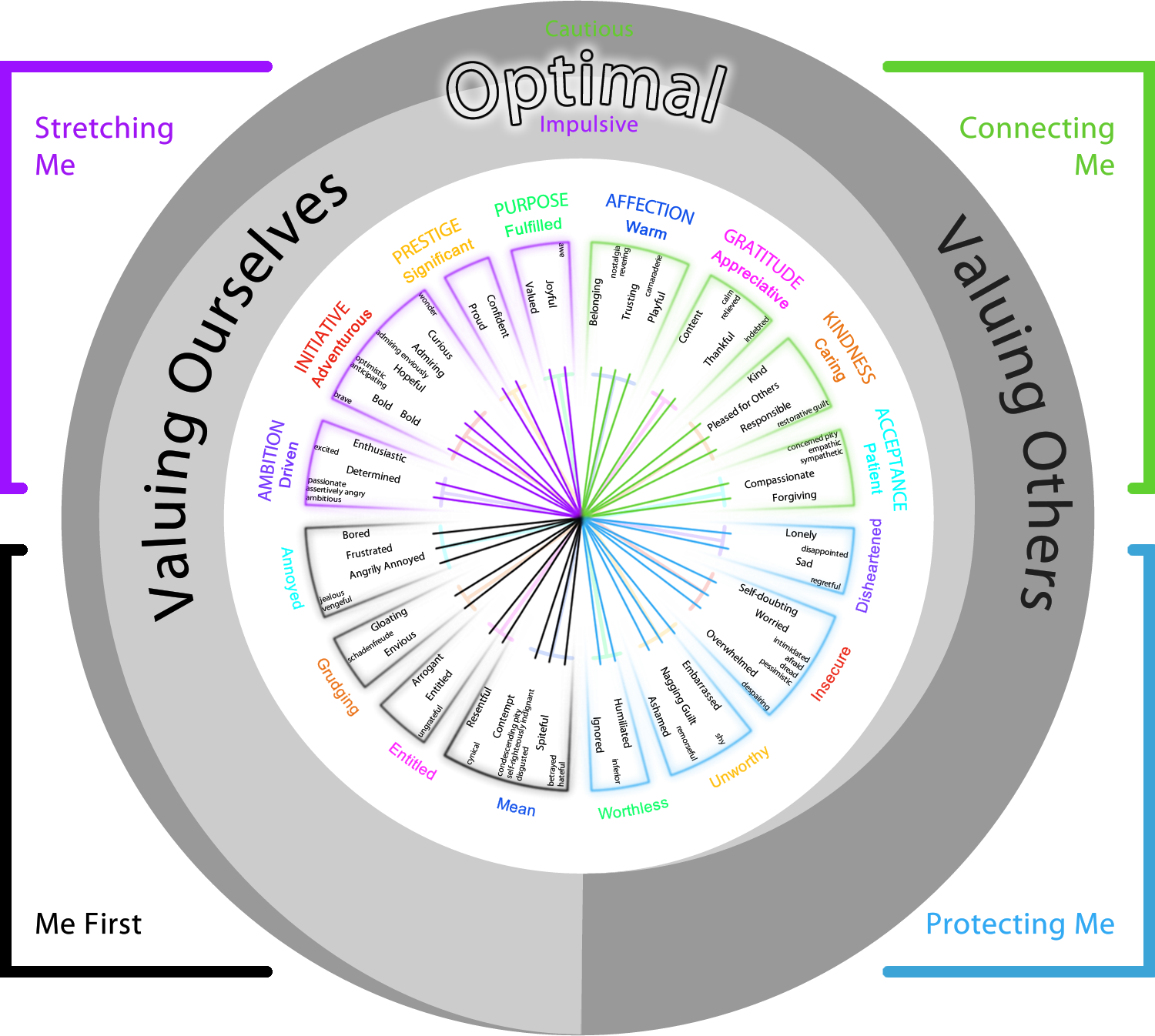The Ring of Emotions
Our mood or affect can be summarised as a state of pleasure, with some degree of arousal. These two dimensions create the quadrants below. The pleasure dimension ranges from up/pleasant to down/aversive. Arousal ranges from fast, as after exercise, to slow, when we're fatigued or resting.
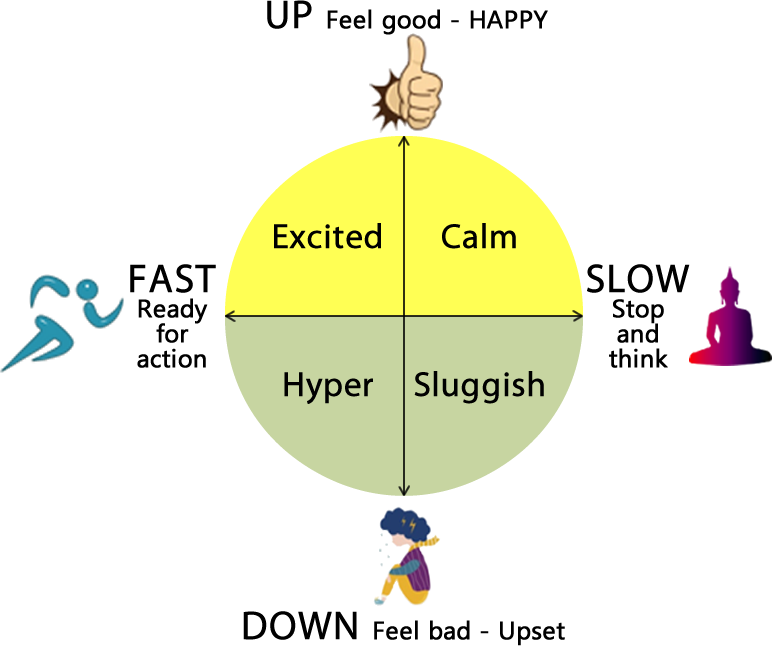
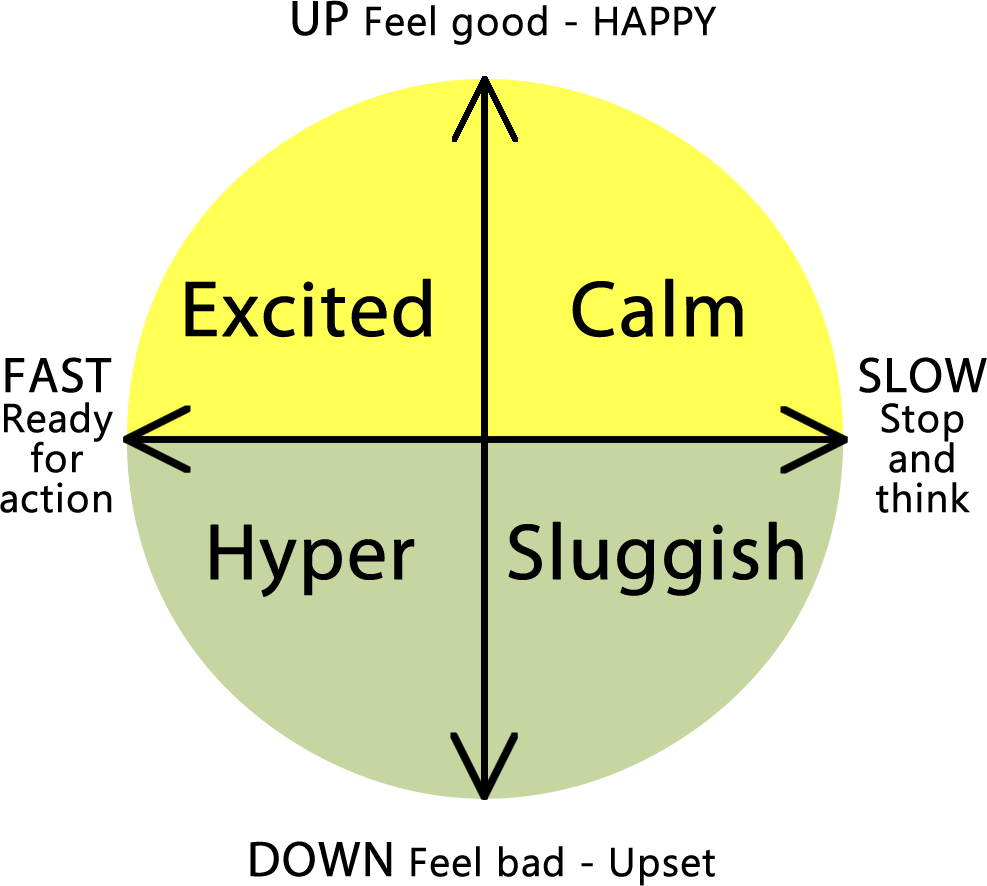
This structure gives us some insight into our emotional state. We need to dig deeper and analyse specific emotions so we can better understand ourselves. We need a cognitive framework to help us.
The 'Ring of Emotions' graphic organiser has been designed as a tool for self-refection and emotional coaching. It's a holistic frame of reference that lets us differentiate individual emotions. We need to understand our emotional experiences through interpreting individual emotions, but this is best done with reference to the whole spectrum of emotions. Every emotion has a purpose and the ring organises emotions by their purpose. Our two fundamental motivating purposes are Valuing our self and Valuing others, life's great balancing act. The model represents these as spirals working in partnership to form a ring.
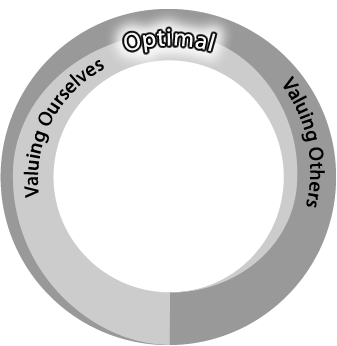
Each spiral begins at the bottom of the ring and grows to a dominating excess at the other end. These extremes are out of balance and this leads to challenging emotions. 40 Emotions are placed around the ring according to their purpose.
The ring is divided into quadrants that overlay the quadrants we saw earlier, each one containing emotions with a distinct shared purpose.
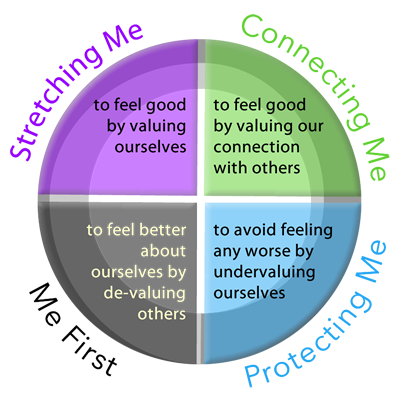
The ring gives us an objective framework to consider how we're currently feeling. Within the balanced top half, there are 20 uplifting emotions or ways to feel good. The bottom half charts an increasing imbalance, where one purpose is taken too far, resulting in 20 challenging emotions or ways to feel bad. This organising structure enables us to consider our emotions in a way that makes their purpose more visible.
We can see emotions which are similar to and different from other emotions. We can think about our emotions in the round, as combinations of uplift and challenge rather than opposites.
To help us make further sense of the purposes of emotions, each quadrant is sub-divided into zones. The zones help us to see the connections between similar emotions, and the distinctions between the uplifting zones and the challenging zones. See Chart 6a and table 6b.
By pairing up mirror-opposite zones we form eight dimensions. These dimensions create a heuristic to map our feelings. We can plot our current emotional experience, attributing ourselves more or less of each zone. See Chart 5, Wellbeing Wheel.
We acquire a special value if the uplifting side in a pair is stronger than the challenging side. These special values are the nutrients of emotional wellbeing. See Chart 7a and table 7b.
Being able to address negative emotions and savour positive emotions is an important part of your toolkit. For a detailed look at how we can do this checkout our Tips for Managing Emotions page.
Finally an overview of the spirals, quadrants, zones and individual emotions is presented. See Chart 8.
Example Emotions Toolkit Lesson
Starter Activity
- If you had only one emotion, which emotion would you chose? Why?
- If you could have your own personal set of emotions that you could feel, and that is all you would feel, which emotions would be in your selection? Write each emotion in a separate post it. Why did you choose these emotions? What would they do for you? Add their purpose to the post it.
- Organise your post its of emotions & purposes into some kind of framework.
Main Activity
- List on separate post its all the emotions you know, understand and experience
- Put the post its into two groups
- an uplifting group - those that feel positive, nourishing, energising, pleasant, comfortable
- a challenging group - those that feel negative, unpleasant, uncomfortable, draining, challenging, agitating.
- Divide the uplifting group into those emotions that are about.
- stretching and valuing yourself
- connecting with and valuing others
- Divide the challenging group into those emotions that are about
- putting yourself first, over-valuing yourself in a selfish way, to restore feeling good about yourself
- worrying about how others see you, over-valuing others, putting yourself down/protecting yourself
- Transfer your labels from the post it notes to the blank ring, (chart 1) placing your emotions in the appropriate quadrant
- Think about experiences you've had where you felt really good. List all the emotions you felt in as much detail as possible. Add any new emotions, placing them appropriately within the ring.
- How did you express what you were feeling?
- Think about experiences you have had where you felt really bad. List all the emotions you felt in as much detail as possible. Add any new emotions, placing them appropriately within the ring.
- How did you express what you were feeling?
- Refer to the Emotion Ring (chart 2). Tick off the emotions you know and understand. Select any that aren't in your personal Emotions chart, but you would like to add. Add them now.
Structure for Discussion
The recommended sequence to use the Ring model as a structure for discussion is to use the Mood Quadrants (Chart 3) then the Attitudes Wheel (Chart 4) before using the Ring of Emotional Wellbeing (Chart 5). If appropriate, go on to explore the emotions involved in the zones (Chart 6a), and then use this as the basis for examining the nutrients of emotional wellbeing (Chart 7a).
Reflection Exercise
Think of a specific context or relationship you want to reflect on.
Locate where you are on each dimension by placing a dot on each line in the particular chart.

Place a dot where you would ideally like to be, indicating with a + sign.
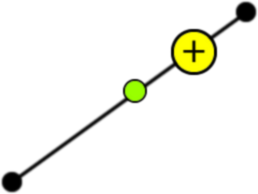
Add an arrowhead to each dot to show the direction you're moving in.
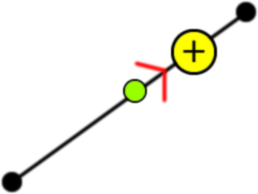
What's happening to place you where you are?
Are there any specific attitude/emotions pulling you down? What's their source?
What attitudes/emotions are lifting you up? What's their source?
What are the uplifting and challenging attitudes/emotions you feel most often?
What attitudes/emotions are missing from your life?
What emotions frighten you the most?
Write down the most important goals you want to achieve and list alongside them the emotions resulting from achieving these goals. This will show you the emotions you value.
What would you need to achieve them?
How well are you achieving the well-being nutrients? Is your balance weighted on the side of wellbeing?
Is either of the motivating purposes (valuing self/valuing others) pulling you too far left or right and out of balance in terms of over-valuing yourself or putting yourself down?
To help you explore what's going on with your feelings, you can use the framework you find most helpful to record daily the emotions you have experienced and what you've been doing.
1 Blank Ring
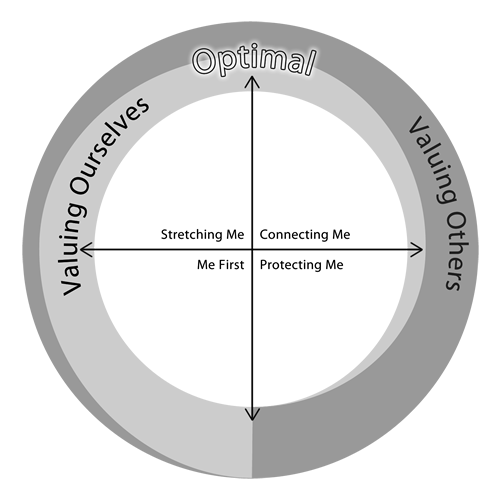
2 Ring of Emotions
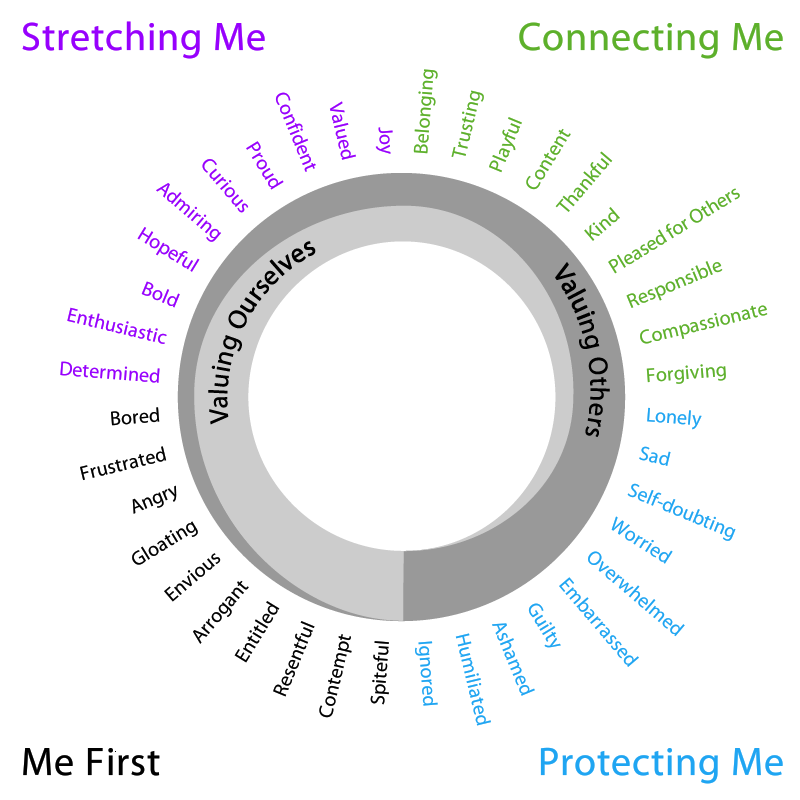
3 Mood Quadrants


4 Attitude Wheel
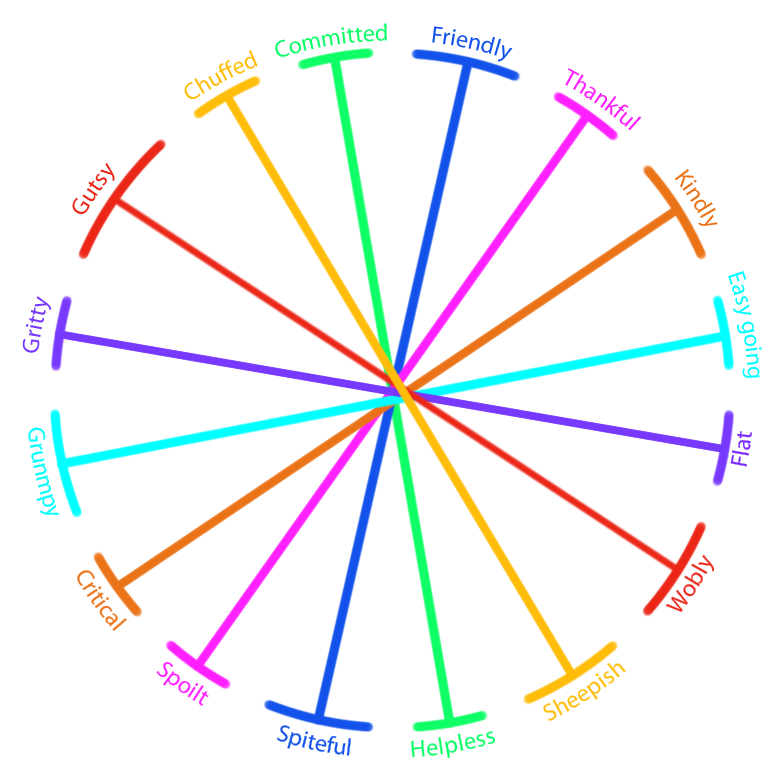
5 Ring of Emotional Wellbeing
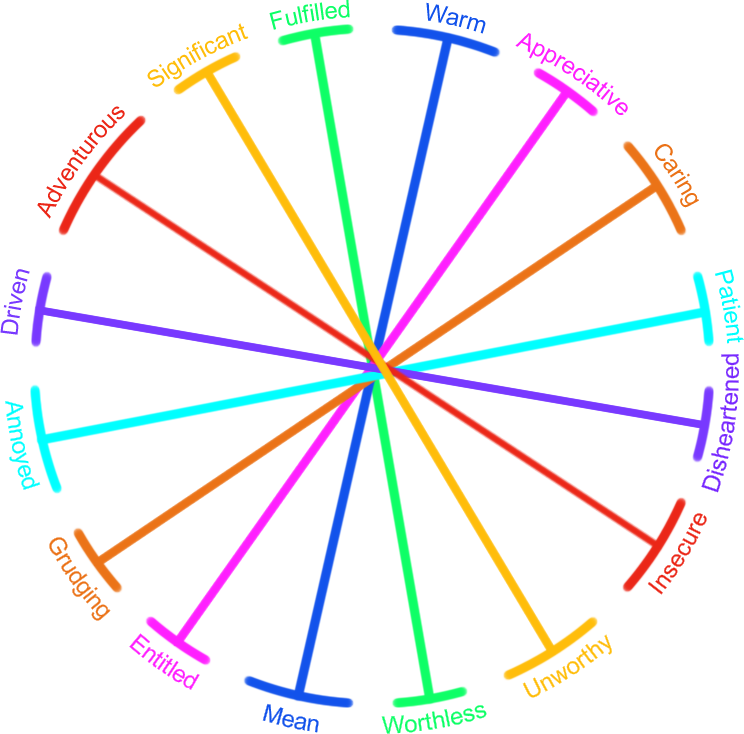
6a The Emotions Zones
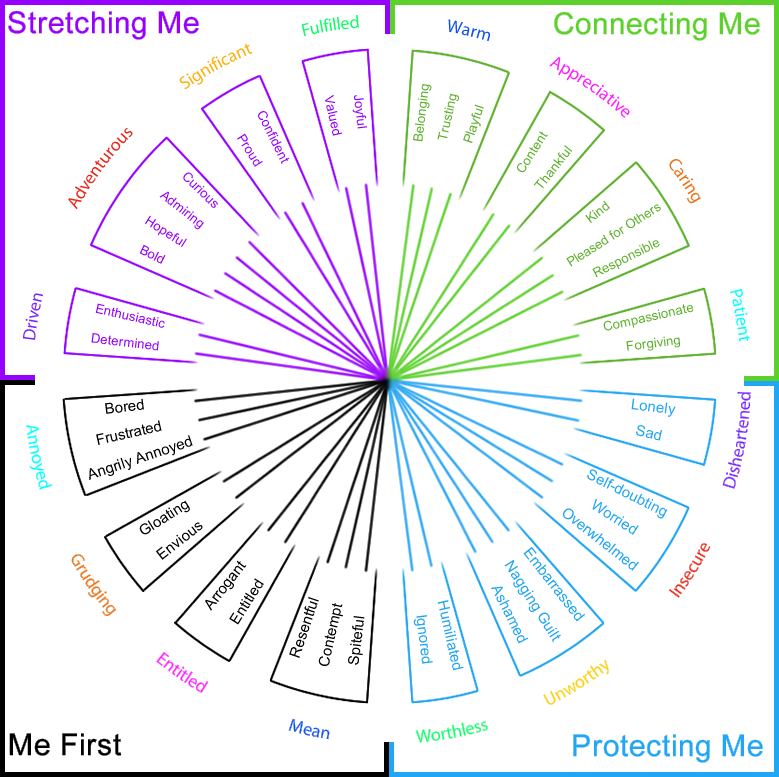
6b The Emotions Zones
Stretching Me Emotions |
|
|---|---|
Fulfilled |
|
|
Exhilatated, Valued |
|
|
Feeling in control and appreciated, we seek new ways to be creative and make a difference. |
|
Significant |
|
|
Pride, Confidence |
|
|
Feeling capable, we embrace opportunities and challenges to further our valued skills and achievements. |
|
Adventurous |
|
|
Curiosity, Admiration, Hope, Courage |
|
|
Spurred on by mystery, possibility and other people, we’re open to risk and discovery. |
|
Driven |
|
|
Enthusiasm, Determination |
|
|
Enthused by purposeful goals, we persevere to achieve and stand out. |
Connecting Me Emotions |
|
|---|---|
Warm |
|
|
Belonging, Trust, Camaraderie |
|
|
Secure in a group that matters to us, we look out for each other. |
|
Appreciative |
|
|
Contentment, Gratitude |
|
|
Grateful for what we have, we make the most of things. |
|
Caring |
|
|
Kindness, Pleased for Others, Responsible |
|
|
Attentive of others’ needs, we monitor how we affect and can help them. |
|
Patient |
|
|
Compassion, Forgiveness |
|
|
Concerned for others, we bear with them, no matter how needy or difficult. |
Me First Emotions |
|
|---|---|
Annoyed |
|
|
Bored, Frustrated, Angry. |
|
|
Blocked, mistreated or fearing losing something to another person, we’re determined to get our own way. |
|
Grudging |
|
|
Envious, Schadenfreude |
|
|
Threatened by comparison with peers, we begrudge them their qualities and welcome any misfortune that befalls them. |
|
Entitled |
|
|
Arrogant, Over-entitled |
|
|
Feeling more important than everyone else, we demand special treatment. |
|
Mean |
|
|
Resentment, Contemptuous, Spiteful |
|
|
Our standing is undermined; we show we’re in charge by putting others down. |
Protecting Me Emotions |
|
|---|---|
Disheartened |
|
|
Lonely, Sad |
|
|
Sad from isolation, loss, or dashed opportunities, we seek consolation and withdraw to get things in perspective. |
|
Insecure |
|
|
Self-doubt, Worried/afraid, Overwhelmed |
|
|
We anticipate the worst and work out ways to minimise risk and regain control. |
|
Unworthy |
|
|
Embarrassment, Guilt, Shame |
|
|
Falling short of expectations and fearing disapproval, we wrestle with our shortcomings and comply to regain approval. |
|
Worthless |
|
|
Ignored, Humiliated |
|
|
Made to feel worthless, we put ourselves down to avoid further hurt. |
7a Nutrients of Wellbeing
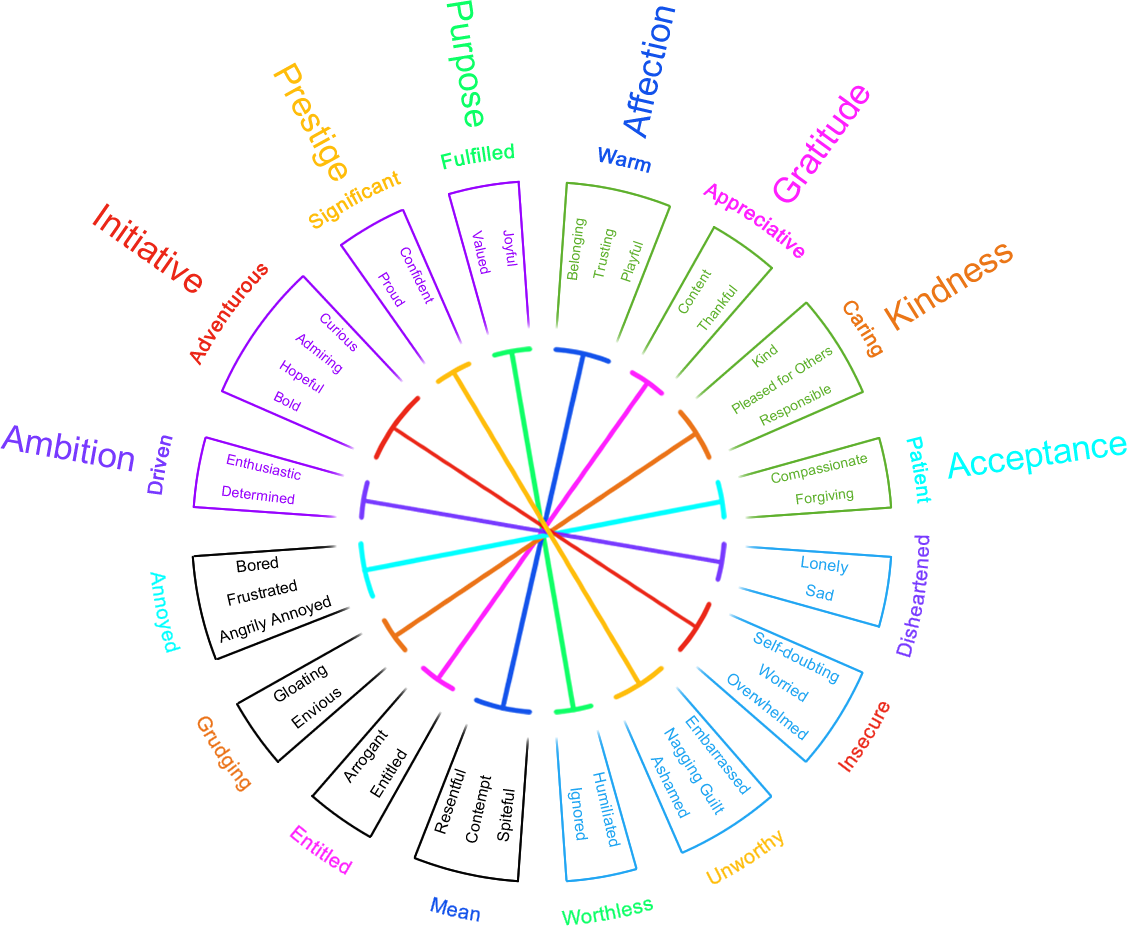
7b The Nutrients of Wellbeing
|
HIGH
|
Emotional Wellbeing Ingredients |
LOW
|
|---|---|---|
|
Fullfilled
|
Purpose The sense of achieving what matters to us, doing what we love and being the kind of person we want to be. People respect or even look up to us. It makes us creative. |
Worthless
|
|
Significant
|
Prestige The honour of having our worth and ability recognised by others. It encourages us to do more. |
Unworthy
|
|
Adventurous
|
Initiative The drive that comes from trust in ourselves and others and belief that we can make a difference to things worth working for. |
Insecure
|
|
Driven
|
Ambition The energy that comes from our sense of purpose and powers us to achieve our goals. It gives us clarity about what we want to achieve. |
Disheartened
|
|
Warm
|
Affection The feeling of being close and comfortable with people. We feel attached to each other and safe to be our real self. |
Mean
|
|
Appreciative
|
Gratitude The appreciation of our good fortune and the kindness of others. |
Entitled
|
|
Caring
|
Kindness The feeling of goodwill towards others and lending them our strength, doing things for others and giving without wanting anything back. |
Grudging
|
|
Patient
|
Acceptance The patience and humility that lets us accept others and things as they are. It stops us judging or blaming others or losing our temper. |
Annoyed
|
8 Overview
